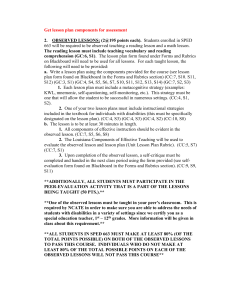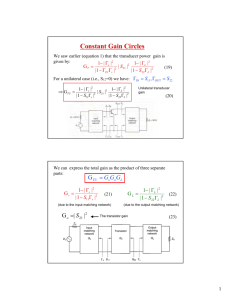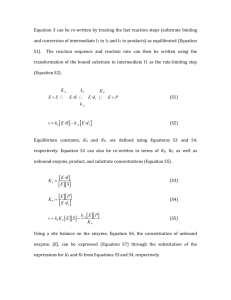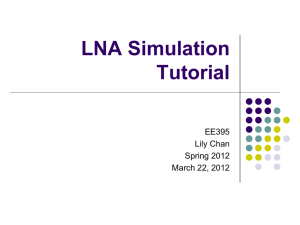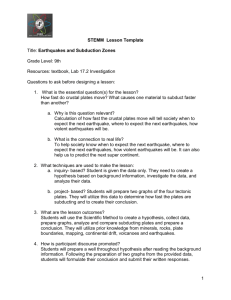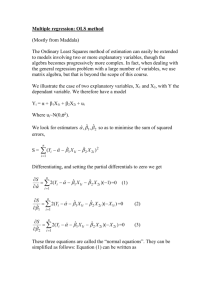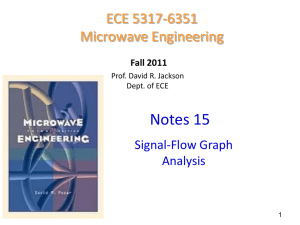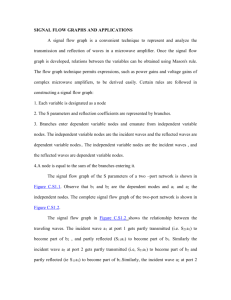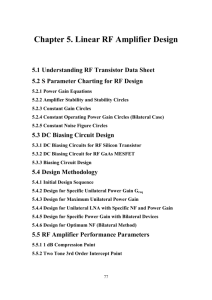Document
advertisement
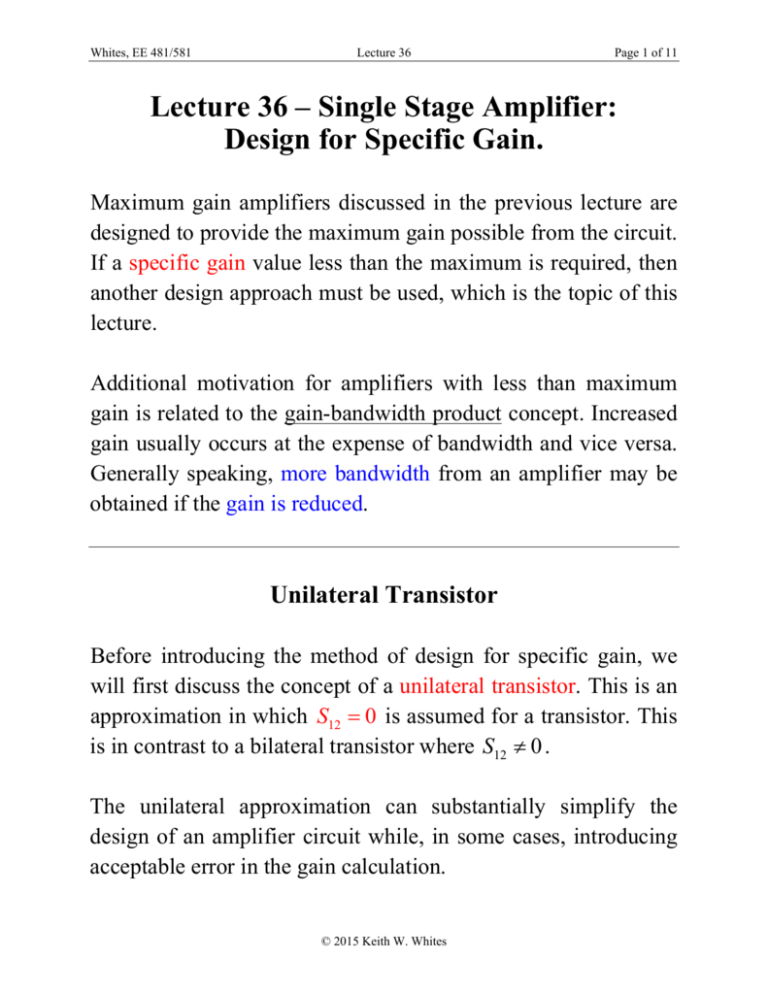
Whites, EE 481/581 Lecture 36 Page 1 of 11 Lecture 36 – Single Stage Amplifier: Design for Specific Gain. Maximum gain amplifiers discussed in the previous lecture are designed to provide the maximum gain possible from the circuit. If a specific gain value less than the maximum is required, then another design approach must be used, which is the topic of this lecture. Additional motivation for amplifiers with less than maximum gain is related to the gain-bandwidth product concept. Increased gain usually occurs at the expense of bandwidth and vice versa. Generally speaking, more bandwidth from an amplifier may be obtained if the gain is reduced. Unilateral Transistor Before introducing the method of design for specific gain, we will first discuss the concept of a unilateral transistor. This is an approximation in which S12 0 is assumed for a transistor. This is in contrast to a bilateral transistor where S12 0 . The unilateral approximation can substantially simplify the design of an amplifier circuit while, in some cases, introducing acceptable error in the gain calculation. © 2015 Keith W. Whites Whites, EE 481/581 Lecture 36 Page 2 of 11 The assumption that S12 0 has some important consequences for the input and output reflection coefficients in a two-port network: Z S Z in Z out Z L Z0 + VS - Input matching network S in l<<1 out L Output matching network Z0 l<<1 In particular, from (12.3a) for the input reflection coefficient and S12 0 : S S in S11 L 12 21 S11 (12.3a),(1) 1 L S22 while from (12.3b) for the output reflection coefficient S S out S22 S 12 21 S 22 (12.3b),(2) 1 S S11 Under the unilateral transistor assumption, we see from these two equations that in is no longer dependent on L and that out is no longer dependent on S . Consequently, the IMN and OMN can be designed independently of one another. This is perhaps the chief benefit of the unilateral assumption. [This is in contrast to the maximum transducer gain amplifier design of a bilateral transistor in the previous lecture where the IMN and the OMN needed to be designed simultaneously, which lead to the design equations (12.40a) and (12.40b).] Whites, EE 481/581 Lecture 36 Page 3 of 11 Using (1) and (2) in the expression for GT [from (12.13) in the text] provides what is called the unilateral transducer gain, GTU, given as 1 | S |2 1 | L |2 2 | S 21 | GTU (12.15),(3) 2 2 |1 S S11 | |1 S 22 L | The error in gain calculated by the unilateral approximation is sometimes quantified through the ratio of GTU to the regular (or “bilateral”) transducer gain GT. As given in the text, this ratio is bounded as 1 GT 1 (12.45),(4) 2 2 1 U GTU 1 U where U is the unilateral figure of merit defined as S11 S 21 S12 S 22 U 2 2 1 S11 1 S 22 (12.46),(5) The unilateral assumption is often found acceptable when the error is less than approximately 0.5 dB or so. We have found that this expression in (4) is actually not correct. You will be investigating this in your homework. Constant Gain Circles The unilateral transducer gain in (3) is the product of three terms GTU GSU G0GLU (6) Whites, EE 481/581 where and Lecture 36 GSU 1 S Page 4 of 11 2 1 S11 S 2 , GLU G0 S 21 2 1 L 2 1 S 22 L 2 (7),(8) (9) The S parameters of the transistor are fixed by the device itself as well as the particular biasing. To achieve a specific gain, which is less than the maximum, from the transistor amplifier circuit, mismatch will be purposefully designed into the input and/or output “matching” networks to yield the gain we seek. In other words, the source and load gain factors in (7) and (8) will be adjusted downward from their maximum values GSU max and GLU max in order to achieve the specified gain. As we discussed in the previous lecture, the maximum GS occurs when there is a conjugate match at the transistor input ( Z S Z in* ), so that for a unilateral device * (10) S *in S11 (1) Likewise, the maximum GL occurs when there is a conjugate * ) so that match at the transistor output ( Z L Z out * * (11) L out S 22 (2) Applying (10) in (7) and (11) in (8) leads to an expression for the maximum unilateral transducer gain, GTU max , given as Whites, EE 481/581 Lecture 36 GTU max 1 1 S11 2 S 21 Page 5 of 11 1 2 1 S 22 2 GSU max G0GLU max (12) where the maximum source and load gain factors for the unilateral device are 1 (12.47a),(13) GSU max 2 1 S11 1 (12.47b),(14) and GLU max 2 1 S 22 We will define normalized gain factors gS and gL to quantify the amount of reduction in the source and load gain factors needed to achieve the desired gain. These factors are given as 2 1 S GSU 2 (12.48a),(15) 1 gS S 11 GSU max 1 S11 S 2 1 L GLU gL GLU max 1 S 22 L 2 and 1 S 2 2 22 (12.48b),(16) so that 0 g S 1 and 0 g L 1. As shown in the text, (15) and (16) can be cast in the forms S CS RS and L CL RL , (17),(18) respectively, where CS RS g S S11* 1 1 g S S11 2 1 g S 1 S11 2 1 1 g S S11 2 (12.51a),(19) (12.51b),(20) Whites, EE 481/581 and Lecture 36 CL RL Page 6 of 11 * g L S 22 1 1 g L S22 2 1 g L 1 S 22 2 1 1 g L S22 2 (12.52a),(21) (12.52b),(22) As we’ve seen many times now, (17) and (18) are equations for circles in the complex S and L planes, respectively. Any value of S or L on these circles will produce the desired normalized gain factor. These so-called constant gain circles can be drawn on a Smith chart to facilitate the design of an amplifier circuit for a specified gain, which is illustrated in the following example. Example N36.1 (Text example 12.4). Design an amplifier for 11 dB gain at 4 GHz. Plot the constant gain circles for GS = 2 dB and 3 dB, and GL = 0 dB and 1 dB. Calculate and plot the input return loss and the overall amplifier gain from 3 to 5 GHz. The FET S parameters, referenced to 50-system impedance, are: f(GHz) 3.0 4.0 5.0 S11 0.80 90 0.75 120 0.71 140 S21 2.8100 2.580 2.360 S12 0 0 0 S22 0.66 50 0.60 70 0.58 85 Whites, EE 481/581 Lecture 36 Page 7 of 11 Since S12 0 , we have a unilateral transistor. (This is just an approximation for a real device, of course, that has a small S12 .) The first step in this design process is to ensure that the device is unconditionally stable at 4.0 GHz. With S12 0 , the mu stability factor is 2 2 1 S11 1 S11 * S22 S11 S 21S12 S22 S11* S11S 22 If S11 1 and S22 1 then > 1, so this FET is unconditionally stable. From (13) and (14), the maximum gain factors at 4 GHz are 1 GSU max 2.29 3.59 dB 1 0.752 1 and GLU max 1.56 1.94 dB 1 0.602 Additionally, from (9) 2 G0 S21 2.52 6.25 7.96 dB Consequently, the maximum unilateral transducer gain from this FET at 4 GHz is the sum of these dB factors: GTU max 3.59 dB 1.94 dB 7.96 dB 13.50 dB Only 11-dB transducer gain is requested, so there is an extra 2.5 dB of gain. Whites, EE 481/581 Lecture 36 Page 8 of 11 We’ll arbitrarily choose GSU 2 dB (reducing 1.59 dB) and GLU 1 dB (reducing by 0.94 dB) to reach 11 dB overall gain, as were chosen in the text. From (15) and (16): GSU GLU 102 10 101 10 gS 0.69 and g L 0.81 GSU max 2.29 GLU max 1.56 Using these values in (19)-(22) gives the parameters for the constant gain circles to be CS 0.63120º and RS 0.17 CL 0.52 70º and RL 0.30 while These circles are drawn on the Smith chart below (Fig. 12.8), along with the GS = 3 dB and GL = 0 dB circles. The next step is to choose S and L values on these circles. There are an infinite number of possibilities, but the points marked on the Smith chart S 0.33120º and L 0.2270º (23),(24) are those closest to the origin and provide the best match at 4 GHz. Presumably, these will also lead to a broader bandwidth. Whites, EE 481/581 Lecture 36 Page 9 of 11 Notice the points GSmax and GLmax . These are actually the points CS max and CL max from (19) and (21), respectively, with g S 1 and g L 1, respectively. Think of these as constant gain circles with radius equal to zero, which is what they actually are. The final step is to design the input and output “matching” networks to provide the necessary amount of mismatch in the IMN and OMN dictated by (23) and (24). Whites, EE 481/581 Lecture 36 Page 10 of 11 Most any type of lossless matching network could be used for this function. Your text chose shunt open circuit stubs, as shown in the figure below (Fig. 12.8). (The design process for this stub design is identical to that discussed in Example N35.1) The resulting unilateral transducer gain GTU and return loss (-RL) are shown as well, as computed from a CAD package. L 0.2270º S 0.33120º A gain of approximately 11 dB was achieved at 4 GHz, with a return loss of approximately 5 dB (which is not too good, but a necessary byproduct to reduce the gain by 2.5 dB). The relative bandwidth over which GTU varies by less than 1 dB is approximately 25%. This is significantly larger than that for the Whites, EE 481/581 Lecture 36 Page 11 of 11 maximum gain amplifier we designed in Lecture 35, though a different transistor was used in that example so a direct comparison of the results from these two examples is not accurate.
